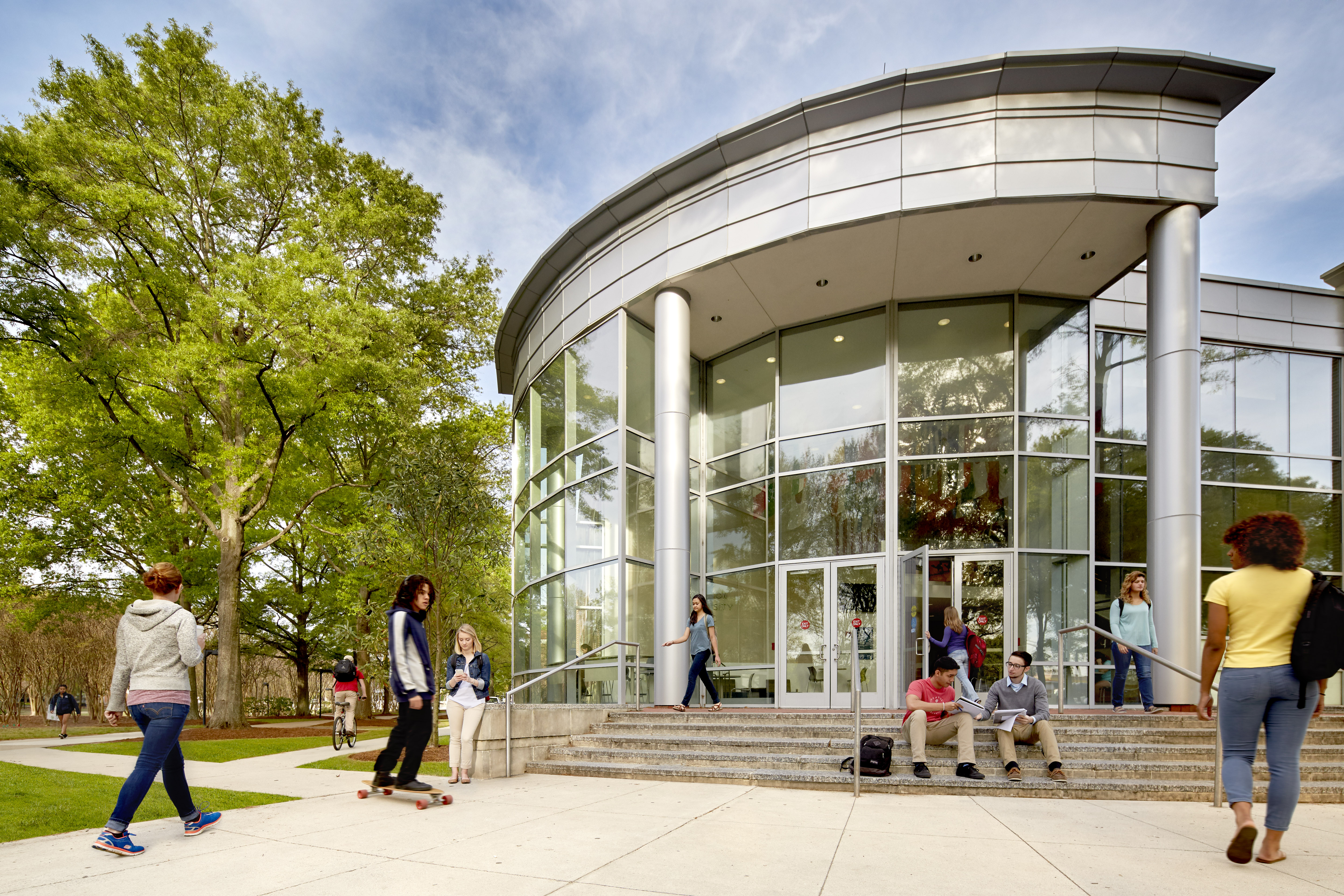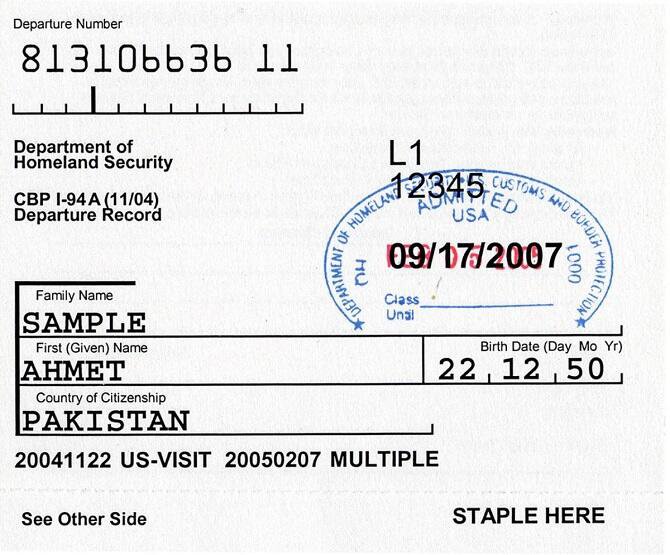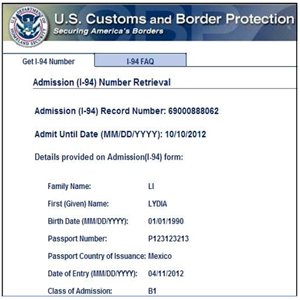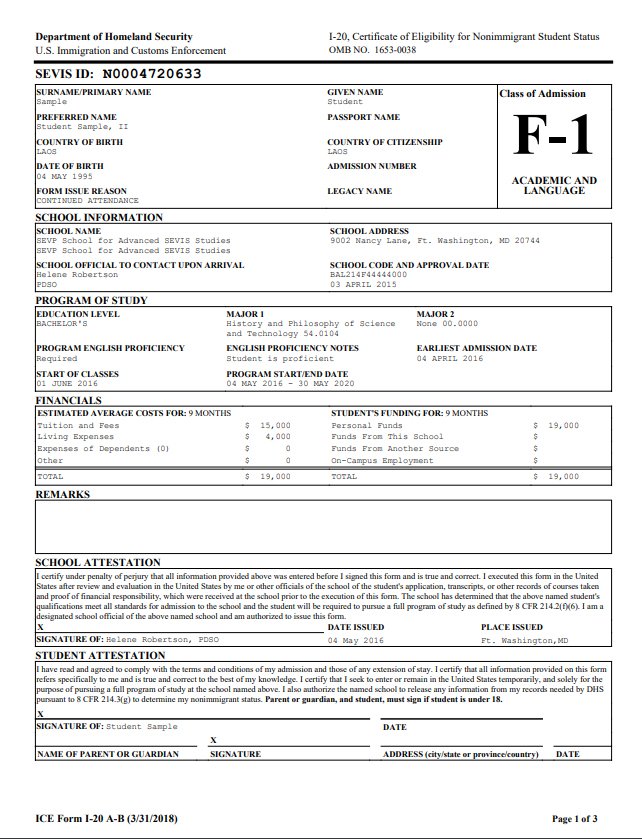The following information references employment information for international students on an F-1 visa; for questions on employment eligibility for students on other visas, please contact our office.
Curricular Practical Training (CPT) Basics for Employers
Internships for international students on F-1 (student) visas are allowed under immigration regulations which permit Curricular Practical Training (CPT). As described in the Code of Federal Regulations [8 CFR 214.2(f)(10)(i)], this employment is "alternate work/study, internship, (or) cooperative education" which is "an integral part of the established curriculum." As CPT is considered a part of the student's course of study, permission is given only for a specific internship and not for employment.
CPT participants must have an I-20 visa document bearing an endorsement for the specific internship site from our office, as well as a valid passport. Part-time CPT is 1-20 hours per week and full-time is anything above 20 hours. CPT is also granted for specific dates, which correspond to the University's academic terms. Sometimes, this authorization can be extended for another semester, but the student must complete a new application with our office. Any changes in internship site, duties or hours require the issuance of a new I-20.
FAQs for Employers/Site Supervisors
U.S. Citizenship & Immigration Services (USCIS) has created this program as a visa status benefit to allow individuals on an F-1 Student visa to apply classroom knowledge in practical situations. These positions, paid or unpaid, are internships that run within the dates of the normal semester, as they are classes for which the students must register.
To ensure an internship meets Immigration and university requirements, students must go through an application process that involves their academic department, Career Development Services (CDS) and Visa & Immigration Service Advising (VISA). Upon approval, students get an I-20 visa document with your company's name and detailed information about the internship. By issuance of the I-20, US Citizenship & Immigration Services has also been notified of the student's internship.
The entire application process takes 2-3 weeks. (NOTE: To avoid Immigration and Department of Labor violations, students may not work--even as a volunteer--before their I-20 is issued.)
An internship offer letter on letterhead is required; details on what information must be included can be found on our CPT offer letter template. Career Development Services also has various job duty and evaluation forms for the student and the supervisor to complete.
CPT is a class, so the work should be done within the same dates of a class in a semester. Students may only do full-time (21 or more hours per week) internships during the final semester of their program and during the summer break. It is also possible to do one part-time CPT in any semester once a student has been here for one full academic year in full-time student status.
Unfortunately, no. CPT is a class for which students register and, therefore, students may only participate in internships within the University-established semester dates.
This is possible only in certain cases provided the internship is done within the parameters of the limitations previously mentioned. Upon graduation, students can also apply to work under Optional Practical Training (OPT); the OPT authorization is for 12 months. For certain majors, an additional 24 months can be requested.
Documentation used for I-9s include the student's passport, I-20 and I-94 departure card. See below for examples of the I-94 and the I-20.
Please refer to IRS Publication 515 or to IRS Publication 519 for full information on exemptions for F-1 Student visa holders.
There is no limit to the number of hours an intern can work in a week while on full-time CPT (more than 20 hours per week). However, part-time CPT has a limit of 20 hours.
Most student must wait until their graduation to begin longer-term employment via Immigration employment authorization called Optional Practical Training (OPT). During this time, your company can seek legal counsel on making an application for an H-1B visa (a relatively simple process).
VISA would be happy to answer any questions and be a resource to you on CPT, OPT and cultural issues. Please feel free to e-mail us.
Optional Practical Training (OPT) Basics for Employers
Optional Practical Training (OPT) is a year of post-graduation employment offered to students by US Citizenship & Immigration Services; students with a major in the Science, Technology, Engineering and Mathematics fields are eligible to apply for an additional 24 months (for a total of 3 years). With OPT, students are responsible for finding employment directly related to their major and for submitting updates to our office when there are any changes in employment. They receive an I-20 with our endorsement and an Employment Authorization Document (EAD card) from US Citizenship & Immigration Services that indicates the time frame for the work permission.
FAQs for Employers/Site Supervisors
U.S. Citizenship & Immigration Services (USCIS) has created this immigration benefit to allow individuals on an F-1 Student visa to work in a position directly related to their degree. These positions are not part of their academic curriculum and take place after the student has completed his/her coursework. Students are able to work up to one year on "Regular" OPT.
USCIS has also established a second type of OPT known as STEM OPT (for Science, Technology, Engineering and Math degrees). This new OPT allows students who graduated with majors in one of these areas to work for an additional 24 months.
Regular OPT authorizations are only granted for 12 months. If, as mentioned above, the student majored in one of the STEM degrees, an additional 24 months can be authorized--allowing a total of 3 years.
Even if the student you hire is only eligible for Regular OPT, there are options for keeping an individual employed with your company after the 12 months ends. See below for further information ("What if our company would like to hire this student for permanent employment?").
Students must first attend a workshop at ODU that explains their rights and responsibilities with regard to OPT. Afterward, they can submit the paperwork to VISA and, if all requirements are met, a new F-1 visa document is used to show our office's endorsement of the application. This part of the process can take up to ten business days.
Next, the student sends the paperwork to US Citizenship & Immigration Services where it can take up to approximately 90 days for the employment permission to be granted. Upon approval, an Employment Authorization Document (EAD or I-766) is issued. In order to avoid Department of Labor and Immigration violations, students cannot work--even as a volunteer--before they receive their EAD and/or before the EAD start date has arrived.
Documentation used for I-9 validation will include the student's passport, as well as the EAD card's number and expiration date. Documentation examples can be found below.
For more information on taxation for F-1 visa holders, please visit the resources complied by the IRS.
Yes. An expired visa stamp does not indicate a violation of a visa status as the visa stamp is issued for entry purposes only. A valid EAD, a properly endorsed I-20 and a valid passport are the only documents required to maintain status while on OPT.
There is no limit to the number of hours per week or the number of employers s/he may have. A student can be a volunteer for at least 20 hours per week, provided that the work does not violate any labor laws. Our office recommends students contact a labor lawyer or a company's HR office to verify whether or not their volunteer work is in compliance.
The most common immigration step following OPT is an H-1B visa, which allows an individual to work at your company up to six additional years. This process is relatively simple and requires assistance from an immigration attorney who can guide you through the application. ODU policy prevents us from recommending a lawyer, but we can suggest the following criteria for assistance in selecting legal counsel for immigration purposes:
-
is a member of the American Immigration Lawyers Association (AILA)
-
has a fixed--not hourly--fee for services like an H-1B employment visa application
-
practices immigration law only
The visa status change takes anywhere from three to seven months, depending on the processing you choose--normal or expedited.
Here is a typical progression of employment options that most students take:
-
Regular OPT: 12 months of employment
-
STEM OPT (if eligible): 24 months of employment
-
H-1B: 6 years of employment
Immigration and tax laws are subject to change; therefore, we recommend you stay in touch with legal counsel who specialize in this area of the law.
Documentation used for I-9 validation will include the student's passport, as well as the EAD card's number and expiration date. Further documentation examples of the EAD (also known as Employment Authorization Document or I-766), I-94 card and I-20 F-1 Student visa document can be found below.
Curricular Practical Training (CPT) Basics for Employers
Internships for international students on F-1 (student) visas are allowed under immigration regulations which permit Curricular Practical Training (CPT). As described in the Code of Federal Regulations [8 CFR 214.2(f)(10)(i)], this employment is "alternate work/study, internship, (or) cooperative education" which is "an integral part of the established curriculum." As CPT is considered a part of the student's course of study, permission is given only for a specific internship and not for employment.
CPT participants must have an I-20 visa document bearing an endorsement for the specific internship site from our office, as well as a valid passport. Part-time CPT is 1-20 hours per week and full-time is anything above 20 hours. CPT is also granted for specific dates, which correspond to the University's academic terms. Sometimes, this authorization can be extended for another semester, but the student must complete a new application with our office. Any changes in internship site, duties or hours require the issuance of a new I-20.
FAQs for Employers/Site Supervisors
U.S. Citizenship & Immigration Services (USCIS) has created this program as a visa status benefit to allow individuals on an F-1 Student visa to apply classroom knowledge in practical situations. These positions, paid or unpaid, are internships that run within the dates of the normal semester, as they are classes for which the students must register.
To ensure an internship meets Immigration and university requirements, students must go through an application process that involves their academic department, Career Development Services (CDS) and Visa & Immigration Service Advising (VISA). Upon approval, students get an I-20 visa document with your company's name and detailed information about the internship. By issuance of the I-20, US Citizenship & Immigration Services has also been notified of the student's internship.
The entire application process takes 2-3 weeks. (NOTE: To avoid Immigration and Department of Labor violations, students may not work--even as a volunteer--before their I-20 is issued.)
An internship offer letter on letterhead is required; details on what information must be included can be found on our CPT offer letter template. Career Development Services also has various job duty and evaluation forms for the student and the supervisor to complete.
CPT is a class, so the work should be done within the same dates of a class in a semester. Students may only do full-time (21 or more hours per week) internships during the final semester of their program and during the summer break. It is also possible to do one part-time CPT in any semester once a student has been here for one full academic year in full-time student status.
Unfortunately, no. CPT is a class for which students register and, therefore, students may only participate in internships within the University-established semester dates.
This is possible only in certain cases provided the internship is done within the parameters of the limitations previously mentioned. Upon graduation, students can also apply to work under Optional Practical Training (OPT); the OPT authorization is for 12 months. For certain majors, an additional 24 months can be requested.
Documentation used for I-9s include the student's passport, I-20 and I-94 departure card. See below for examples of the I-94 and the I-20.
Please refer to IRS Publication 515 or to IRS Publication 519 for full information on exemptions for F-1 Student visa holders.
There is no limit to the number of hours an intern can work in a week while on full-time CPT (more than 20 hours per week). However, part-time CPT has a limit of 20 hours.
Most student must wait until their graduation to begin longer-term employment via Immigration employment authorization called Optional Practical Training (OPT). During this time, your company can seek legal counsel on making an application for an H-1B visa (a relatively simple process).
VISA would be happy to answer any questions and be a resource to you on CPT, OPT and cultural issues. Please feel free to e-mail us.
Optional Practical Training (OPT) Basics for Employers
Optional Practical Training (OPT) is a year of post-graduation employment offered to students by US Citizenship & Immigration Services; students with a major in the Science, Technology, Engineering and Mathematics fields are eligible to apply for an additional 24 months (for a total of 3 years). With OPT, students are responsible for finding employment directly related to their major and for submitting updates to our office when there are any changes in employment. They receive an I-20 with our endorsement and an Employment Authorization Document (EAD card) from US Citizenship & Immigration Services that indicates the time frame for the work permission.
FAQs for Employers/Site Supervisors
U.S. Citizenship & Immigration Services (USCIS) has created this immigration benefit to allow individuals on an F-1 Student visa to work in a position directly related to their degree. These positions are not part of their academic curriculum and take place after the student has completed his/her coursework. Students are able to work up to one year on "Regular" OPT.
USCIS has also established a second type of OPT known as STEM OPT (for Science, Technology, Engineering and Math degrees). This new OPT allows students who graduated with majors in one of these areas to work for an additional 24 months.
Regular OPT authorizations are only granted for 12 months. If, as mentioned above, the student majored in one of the STEM degrees, an additional 24 months can be authorized--allowing a total of 3 years.
Even if the student you hire is only eligible for Regular OPT, there are options for keeping an individual employed with your company after the 12 months ends. See below for further information ("What if our company would like to hire this student for permanent employment?").
Students must first attend a workshop at ODU that explains their rights and responsibilities with regard to OPT. Afterward, they can submit the paperwork to VISA and, if all requirements are met, a new F-1 visa document is used to show our office's endorsement of the application. This part of the process can take up to ten business days.
Next, the student sends the paperwork to US Citizenship & Immigration Services where it can take up to approximately 90 days for the employment permission to be granted. Upon approval, an Employment Authorization Document (EAD or I-766) is issued. In order to avoid Department of Labor and Immigration violations, students cannot work--even as a volunteer--before they receive their EAD and/or before the EAD start date has arrived.
Documentation used for I-9 validation will include the student's passport, as well as the EAD card's number and expiration date. Documentation examples can be found below.
For more information on taxation for F-1 visa holders, please visit the resources complied by the IRS.
Yes. An expired visa stamp does not indicate a violation of a visa status as the visa stamp is issued for entry purposes only. A valid EAD, a properly endorsed I-20 and a valid passport are the only documents required to maintain status while on OPT.
There is no limit to the number of hours per week or the number of employers s/he may have. A student can be a volunteer for at least 20 hours per week, provided that the work does not violate any labor laws. Our office recommends students contact a labor lawyer or a company's HR office to verify whether or not their volunteer work is in compliance.
The most common immigration step following OPT is an H-1B visa, which allows an individual to work at your company up to six additional years. This process is relatively simple and requires assistance from an immigration attorney who can guide you through the application. ODU policy prevents us from recommending a lawyer, but we can suggest the following criteria for assistance in selecting legal counsel for immigration purposes:
-
is a member of the American Immigration Lawyers Association (AILA)
-
has a fixed--not hourly--fee for services like an H-1B employment visa application
-
practices immigration law only
The visa status change takes anywhere from three to seven months, depending on the processing you choose--normal or expedited.
Here is a typical progression of employment options that most students take:
-
Regular OPT: 12 months of employment
-
STEM OPT (if eligible): 24 months of employment
-
H-1B: 6 years of employment
Immigration and tax laws are subject to change; therefore, we recommend you stay in touch with legal counsel who specialize in this area of the law.
Documentation used for I-9 validation will include the student's passport, as well as the EAD card's number and expiration date. Further documentation examples of the EAD (also known as Employment Authorization Document or I-766), I-94 card and I-20 F-1 Student visa document can be found below.






